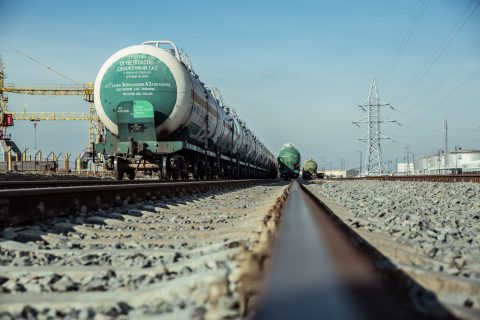Kazakhstan’s growing importance in transport routes

Kazakhstan’s role in Eurasian transportation during recent years is indisputable. The country sees significant volumes transported through its railway infrastructure yearly. A crucial transit destination for trade in the New Silk Road and a primary component of the Middle Corridor (Trans-Caspian International Transport Route), Kazakhstan is exploring its growing potential also as an export country.
The first rail shipment between China and Europe (Duisburg) that used Kazakhstan’s railways took place in 2011. Two years later, when China’s Belt and Road Initiative got announced, the country directly adopted the ‘Nurly Zhol’ national program for infrastructure development. The program targeted to fully integrate with the New Silk Road’s objectives and increase transit volumes through the country by improving infrastructure. A few years later, multiple rail connections have already been established with other countries, accompanied by port services in the Caspian Sea.
Simultaneously, steps for the optimisation of the Middle Corridor’s services are continuously underway, making Kazakhstan a fast-growing country in terms of rail transportation and interconnectivity. Currently, authorities and parties concerned focus on improving the technological and logistic aspect of services, in coordination with neighbouring countries.
Transit country
Over the past ten years, around thirty US billion dollars have been invested in the country’s transport and logistics infrastructure to facilitate the development of Eurasian trade and transportation corridors.
Numbers concerning the usage of Kazakhstan in the China-Europe-China route are indicative. For instance, during 2019, approximately 347,000 TEUs were transported through the country, 12 per cent more than the year before. For 2020, and if we take into account the pandemic’s impact on global transport, the country expects an overall increase in traffic up to 45-50 per cent more than last year. Only in the first ten months of the year traffic between Europe and China exceeded 400,000 TEUs, as a result reaching and transcending the landmark number of half a million TEUs is more than a realistic goal.
Growth and improvement
From 2011 on volumes of cargo transported through Kazakhastan have reached tremendous increase rates. Container traffic in the country has since then seen a 385-fold increase, while traffic only in the EU-China route has seen a two-fold increase. It must also be noted that 90 per cent of the China-Europe-China container traffic passes through the Central Asian country. Kazakhstan has, thus, become a major hub for Eurasian traffic and is looking forward to centralising its position even more.
How will this be achieved, however? According to Aigul Kuspan, Ambassador of Kazakhstan in Belgium and Head of Permanent Mission of Kazakhstan to the EU, the country is currently focusing on adapting quickly in the trends related to the development of e-commerce. Additionally, it comprehends and enhances the need for “advanced and diversified development” in the sectors of logistics infrastructure and capacities. Subsequently, the transport industry of the country is intensively working towards these directions. Among the immediate goals set one can find the covering of longer distances by trains daily, the elimination of emergencies and the safety of products.
MIddle corridor
With regards to the Middle Corridor that passes through China, Kazakhstan, Azerbaijan and Georgia on the way to Europe, the Central Asian country sees many benefits. It might not be among the main routes used in the New Silk Road, but it nevertheless constitutes a very reliable alternative and a key driver for developments.

For instance, associated countries in the TITR are conjointly working on digitalisation issues, as well as on commercial and technical services. Each member of the association offers its knowledge and tools that can contribute to the growth of the corridor’s traffic and the sharing of knowledge. Kazakhstan can surely benefit from this kind of cooperation and integrate operational solutions to its systems.
Seaports
Nevertheless, the country also benefits in more practical ways from being a member of the corridor. First of all, it has acquired better connections with Europe through Turkey and Ukraine who are closely cooperating with TITR. Furthermore, and due to the sharing of the Caspian Sea with Azerbaijan, Kazakhstan was ‘forced’ to develop its sea transportation services too.
The ports of Aktau and Kuryk have gained much importance lately since they constitute the only maritime gateway for the country in the closed Caspian Sea. They might not be on the coastline of a significant sea. Still, they have managed to transform the Caspian route with modern infrastructure and thus facilitate transportation towards Azerbaijani ports like that of Baku. For a landlocked country, these developments are quite important and indicate a collective effort and tendency for growth.

Export trade
Among the most interesting facts about Kazakhstan at the moment, is something that many times gets overlooked. Most of the focus on the country lies on its function as a transit destination for routes across the New Silk Road. However, little attention is paid to the fact that Kazakhstan is also an exporting country. Impressively, for 2019, 54 per cent of the country’s GDP belonged to foreign trade. In general, Kazakhstan exports products to 89 countries around the world. It is some European states and China though who have the most significant share in this relationship.
Revenues from exports to China equal the amount of 8 billion per year, but Italy comes first because it imports products equal to 8,4 billion per year. Europe is a crucial component of Kazakhstan’s foreign trade since it occupies 32 per cent of it. Apart from Italy, the Netherlands and France also collaborate closely with the country. The main products exported to Europe include oil, oil products, petrochemicals, liquid gas, ferrous and non-ferrous metals, as well as grains and fertilisers.
All in all, Kazakhstan is working on improving its image and presence in the international trade markets. From an insignificant ex-USSR country, it has managed to become a pivotal transit destination for the New Silk Road, a founding member of the Middle Corridor, and a landlocked country with developed ports, increasingly improved infrastructure and services, and strong export trade. One would say that considering the circumstances Kazakhstan is on the right track to becoming a key player for rail transportation in the future.
You just read one of our premium articles free of charge
Want full access? Take advantage of our exclusive offer




